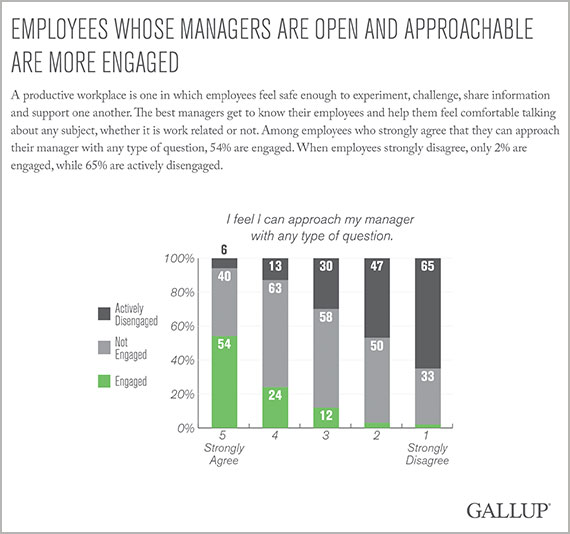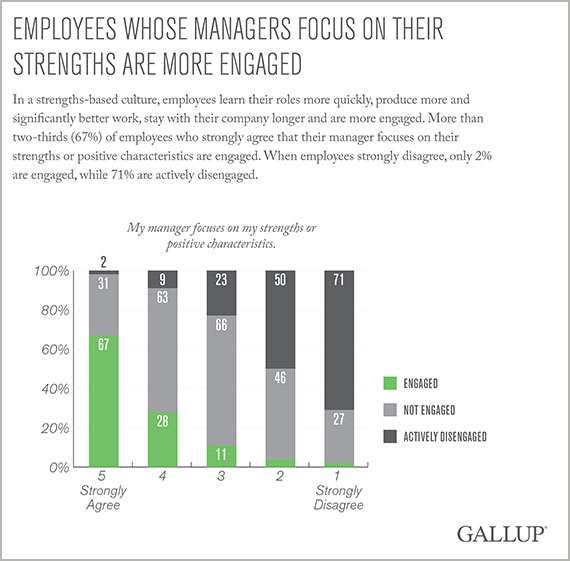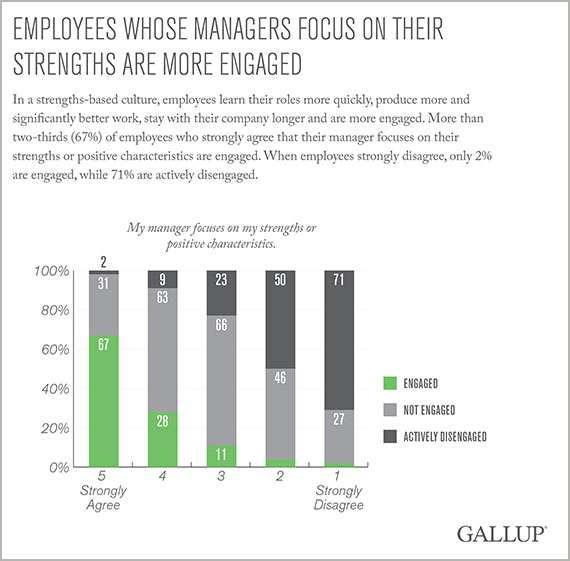What’s your employee engagement level?
There’s a simple tool to discover this. It’s Gallup’s Q12. ![12 Elements of Great Managing [Gallup] resized 600](http://cdn2.hubspot.net/hub/78084/file-15608549-gif/images/12_elements_of_great_managing_[gallup]-resized-600.gif?width=286&height=300&name=12_elements_of_great_managing_[gallup]-resized-600.gif) If you’ve not read First Break All the Rules you’re missing perhaps one of the most instructive How To management books of this century.
If you’ve not read First Break All the Rules you’re missing perhaps one of the most instructive How To management books of this century.
Gallup is a premier performance-management consulting company long known for their public opinion polls.
Employee engagement in the United States remains consistently less than one third of a company’s staff. Employee engagement is the emotional commitment the employee has to the organization and its goals. A 2012 Forbes article indicates this emotional commitment means engaged employees actually care about their work and their company. They don’t work just for a paycheck, or just for the next promotion, but work on behalf of the organization’s goals.
When employees care—when they are engaged—they use discretionary effort.
Does that sound like something you’d like to bottle and serve to your team?
Who’s primarily responsible for these low scores, which by the way are much worse in most worldwide countries? Just as the top reason people leave a company is their boss, so is it true here with employee engagement. Gallup’s recent research shows that managers account for as much as 70% of variance in employee engagement scores. Most managers are simply not creating environments in which employees feel motivated or even comfortable. It’s interesting to note another research by Gallup that indicated one in two adults had left their job to get away from their manager to improve their overall life at some point in their career.
The issue with a bad manager is that employees feel miserable while at work, and that misery follows them home, compounding their stress and negatively affecting their overall well-being.
Ask yourself, have you ever thought about that when considering whether a manager in your organization needs to change or have their future freed up?
What can be done, and what should managers focus on? In Employees Want More From Their Managers, Gallup listed three behaviors related to communication, performance measurements, and strengths which strongly link employee engagement and give organizations better insight into developing their manager and raising the bar of performance in their businesses.
Here are some insights from the article along with how Positioning Systems, Gazelles Growth Tools and coaching help our customers achieve higher employee engagement levels
Communication
Great managers have the talent to motivate employees and build genuine relationships with them. Gallup found that consistent communication -- whether it occurs in person, over the phone or electronically -- is connected to higher engagement. For example, employees whose managers hold regular meetings with them are almost three times as likely to be engaged as employees whose managers do not hold regular meetings with them.
.jpg?width=336&height=315&name=graph_-employees_whose_mgr_open_and_approachable_(gallup).jpg) Gallup also found that engagement is highest among employees who have some form (face to face, phone or digital) of daily communication with their managers. When employees attempt to contact their manager, engaged employees report their manager returns their calls or messages within 24 hours. Employees value communication from their manager not just about their roles and responsibilities, but also about what happens in their lives outside of work. The Gallup study revealed that employees who feel as though their manager is invested in them as people are more likely to be engaged.
Gallup also found that engagement is highest among employees who have some form (face to face, phone or digital) of daily communication with their managers. When employees attempt to contact their manager, engaged employees report their manager returns their calls or messages within 24 hours. Employees value communication from their manager not just about their roles and responsibilities, but also about what happens in their lives outside of work. The Gallup study revealed that employees who feel as though their manager is invested in them as people are more likely to be engaged.
As noted in Rockefeller Habits 4 Decisions Tools – People Continued Google management survey concluded that the most successful managers engage in one-on-one coaching with their direct reports. In addition Strategic Discipline’s pattern of daily, weekly, monthly, quarterly and annual meeting rhythms provide the disciplined meeting structure employees require to reach high levels of engagement. And these meetings are short, crisp, consistent, and performance enhancing. Daily huddles guarantee a manager will speak to his employees every 24 hours, and see them daily. The good news in the weekly meeting agenda challenge employees to submit a favorable event from personal and business each week.
Performance Management
A source of great frustration for employees is not to clearly understand their goals or what is expected of them at work. They feel conflicted about their duties and disconnected from the bigger picture. Without clarity on what tomorrow will throw at them it is impossible for them to think about next year's goals.
Gallup found that employees whose managers excel at performance management -resized-600.jpg?width=296&height=291&name=graph_-mgr_help_set_perf_goals_(gallup)-resized-600.jpg) activities are more engaged than employees whose managers struggle with these same tasks. Clarity of expectations is perhaps the most basic of employee needs and is vital to performance. Employees need more than a written job description to fully grasp their role.
activities are more engaged than employees whose managers struggle with these same tasks. Clarity of expectations is perhaps the most basic of employee needs and is vital to performance. Employees need more than a written job description to fully grasp their role.
Engaged employees are more likely to say that their manager holds them accountable for their performance. To these employees, accountability means that their manager treats all employees fairly and holds everyone to the same standards, allowing those with superior performance to shine.
Accountability and performance measures are critical tools in Strategic Disciplines meeting rhythms. Holding employees accountable is done in a fashion Patrick Lencioni (Accountability - Three Reasons Group Meetings Produce Better) recognizes as being most effective, through peer pressure. We address accountability beyond the measurements of performance by tracking each team member’s responsibilities through an accountability chart that is reviewed as well in each weekly meeting. Our recommended tool for hiring and employee evaluations Topgrading, provides a Job Summary Scorecard that goes well beyond most job descriptions providing key activities with metrics to establish “A” performance levels.
One of the foundation principles for improving performance is based on the principle of Pearson’s Law, which is an axiom of performance that Positioning Systems reinforces consistently to successfully produce dramatic increase in performance.
Strengths vs. Weaknesses
Gallup is somewhat of an authority on this subject, having written several best-selling books including Strengths Finder, Strengths Finder 2.0 and Strengths Based Leadership. -resized-600.jpg?width=279&height=274&name=employees_mgrs_focused_on_strengths(gallup)-resized-600.jpg) They’ve discovered that building employees' strengths is a far more effective approach than attempting to fix weaknesses. In a strengths-based culture employees learn their roles more quickly, produce more and significantly better work, stay with their company longer and are more engaged. Gallup’s current study reports a vast majority (67%) of employees who strongly agree that their manager focuses on their strengths or positive characteristics are engaged, compared with 31% of employees who strongly agree that their manager focuses on their weaknesses.
They’ve discovered that building employees' strengths is a far more effective approach than attempting to fix weaknesses. In a strengths-based culture employees learn their roles more quickly, produce more and significantly better work, stay with their company longer and are more engaged. Gallup’s current study reports a vast majority (67%) of employees who strongly agree that their manager focuses on their strengths or positive characteristics are engaged, compared with 31% of employees who strongly agree that their manager focuses on their weaknesses.
At Positioning Systems we’ve used Gallup’s Strengths Based Leadership with our customers (Strategic Discipline Leads to 100% January Revenue Growth) to discover where leadership’s sweet spots are to alleviate bottlenecks and improve productivity. Gazelles introduced another strength based leadership exercise as part of People Decisions called Love and Loathe. Intended to identify what you as a manager love to do and what you hate doing, the action step is to delegate those activities you don’t like and invest more time in what you love. This same exercise can be applied with your people although the action steps may be limited with subordinates. It still makes sense to put your people in their areas of greatest strength to build growth in them and for your business.
Next blog will look at weekly meetings and the value they bring to your organization. Thanks for reading!






.jpeg?width=150&height=135&name=Hand%20with%20marker%20writing%20the%20question%20Whats%20Next_%20(1).jpeg)

